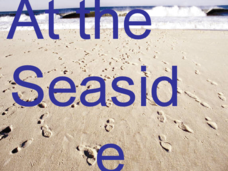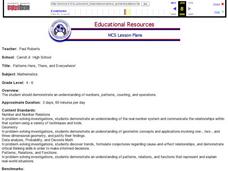Curated OER
Valentine Sorting Activity
Get that thinking cap on and engage your special ed or autistic learners in a fun sorting activity. This resource includes instructions and all printable materials needed to start sorting. They will sort colors blue and red, numbers 1,...
Curated OER
Rule It Out
Here's a way to create math fact flash cards! Learners create their own cards and sort them into matching categories. Students start with addition and work their way up to harder math such as multiplication, and are asked to notice...
Curated OER
Sorting Candy
Lower graders sort and group objects by their different properties. They watch a video about sorting then, sort and organize candy in different groups. Students compare how others sorted their candy. Finally, they decide which group has...
Curated OER
Math Throughout the Day
Learners practice their number sense throughout the day. They practice their use and understanding of numbers in every part of the day. Students watch and listen to the teacher count students in class, sort themselves based on colors or...
Curated OER
Fun With Sorting and Classifying
Using a variety of activities, kindergartners explore sorting and classification. Learners engage in an online sorting activity, read books involving classification, and create their own class book. This is a marvelousway to explore this...
Curated OER
2nd Grade - Act. 17: Source Relay
Help your 2nd graders understand the difference between natural and man-made materials. They will sort breakfast food items into sources: store, factory, natural world, and farm. They will work together to classify, form conclusions, and...
Curated OER
Sorting
Students examine the concept of organization. In this library skills lesson, students practice ordering and sorting skills by playing the Flood Game.
Curated OER
Matter And Materials
Students investigate the concept of identifying different objects in nature and classifying them into different categories. The students will describe and explain a group of the objects orally and in writing form that is appropriate to...
Curated OER
Are You One of Us?
Young scholars compare and contrast insects and arthropods, identifying characteristics of each. In groups, they sort pictures of arthropods into the five different classes of arthropods. They also sort pictures into insect and...
Curated OER
Are You One Of Us?
Young scholars discover how to classify things based on their similarities and differences. Students give the characteristics of insects and create a classification list. Given examples of various types of insects, young scholars...
Curated OER
Classifying Objects into Group
Classifying and sorting are great skills all kids need to know. They cut out each of the six images provided, then label each of two boxes. They glue the images in the appropriate box. Answers are provided.
Curated OER
Vocabulary Instruction: Identify and Sort Common Words into Categories
Kids learn about the concept of nouns. They practice identifying nouns by sorting words into categories. As the teacher holds up each word, the class reads it in unison, then they take turns identifying it as a noun or non noun word....
Curated OER
Sampling Rocks
Young scholars collect and sort rocks based on visible characteristics. In this statistics lesson, students determine adequate sample size and categorize rocks based on characteristics. The book Everybody Needs a Rock is read...
Curated OER
Sorting
Students examine the concepts of organization and classification. In this library skills lesson, students practice ordering and sorting skills by playing an interactive Internet game. Students then practice their classification skills in...
Curated OER
At the Seaside
Encourage sorting and classification skills by asking, "What kinds of things are found at the seaside?" Kids sort objects by calling out the items found at the beach. They can choose from things like balls, dogs, bikinis, shells, and...
Curated OER
Yellow
The color yellow is the star of this simple lanuage worksheet. Learners trace the word yellow, count and sort assorted yellow objects, and color stars with the letter Y.
Curated OER
Sorting
A activity on classification and sorting is here for you. Elementary schoolers participate in an interactive computer game in which they sort books by theme. They take a trip to the library to observe and discuss how books are sorted,...
Curated OER
Patterns Here, There and Everywhere
Pattern recognition is a skill often used in mathematics. Learners count and sort manipulatives, organize the data into a graph and answer questions about the information displayed. They collect the objects to be used and create patterns...
Curated OER
Quarter Sorter
Graphing and sorting are such important skills for young learners to understand. Here, they will be given quarters to examine, they must come up with a sorting rule by which they will use to sort the quarters. They will sort their...
Curated OER
Taking Attendance
Explore punctuality by participating in a daily class activity. They will choose a classmate to be the attendance monitor for a week and he or she becomes responsible for keeping track of who has missed school on which days. They create...
Curated OER
Ready for Roots
Fourth graders sort seeds and predict what conditions are needed for them to germinate. They keep the seeds moist, observe and measure their growth and graph the results. As the seeds start to grow students compare and contrast the each...
Curated OER
Curious Clouds
Second graders explore clouds. They read The Cloud Book by Tomie dePola. Students sort the cloud pictures into three categories. Students create a graph using the cloud pictures. They use Excel to create a bar graph.
Curated OER
Valentine Heart Candy
Each student gets a box of candy Valentine hearts. The students open the box and count how many of each colored heart they have in their box. The students use this information to make a bar graph and answer follow-up questions.
Curated OER
Sorting and Counting Geometric Shapes
Practice counting, tallying, and sorting shapes with this math challenge. Scholars examine a group of shapes, tallying the amount in four categories: quadrilaterals, parallelograms, rectangles, and squares. Then, they color in any shapes...

























